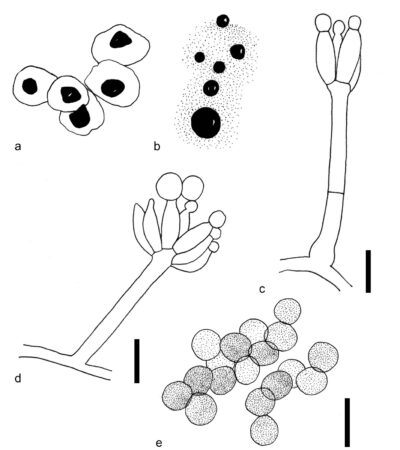Fungalpedia – Note 312, Globobotrys
Globobotrys L. Lombard & Crous
Citation when using this entry: Perera et al. 2024 (in prep.) – Fungalpedia, genera described in 2016.
Index Fungorum, Facesoffungi, MycoBank, GenBank, Fig. 1
Classification: Stachybotryaceae, Hypocreales, Hypocreomycetidae, Sordariomycetes, Pezizomycotina, Ascomycota, Fungi
Lombard et al. (2016) introduced this monotypic genus based on Stachybotrys sansevieriicola (as Globobotrys sansevieriicola), which clustered distantly from the Stachybotrys s.str. clade in the phylogenetic analysis of cmdA, ITS, rpb2, and tub2 sequences. Globobotrys produce macronematous and mononematous conidiophores that occur in solitary or in groups. They are erect, mostly unbranched, 1(–2)-septate, and hyaline, with thin and smooth walls. Conidiogenous cells occur in whorls of 3–8, and the apices of conidiophores are phialidic, subcylindrical to clavate to widely reniform, hyaline, and pale brown. They have thick, smooth walls and conspicuous collarettes. Conidia are aseptate, hyaline to olivaceous brown, globose to broadly ellipsoidal, thick, and smooth-walled, with a truncate hilum and one or two large guttules. The sexual morph remains undetermined (Crous et al. 2015; Lombard et al. 2016). Globobotrys sansevieriicola is associated with the leaves of Sansevieria ehrenbergii (Crous et al. 2015; Lombard et al. 2016).
Type species: Globobotrys sansevieriicola (Crous & M.J. Wingf.) L. Lombard & Crous
Other accepted species: This genus is monotypic.
Figure 1 – Globobotrys sansevieriicola (CPC 24316, ex-type). a Symptoms in leaf. b Colony. c Conidiophores and conidiogenous cells. d Conidia. Scale bars: a–b = 10 μm. Redrawn from Crous et al. (2015)
References
Entry by
Rekhani Hansika Perera, Center of Excellence in Fungal Research, Mae Fah Luang University, Chiang Rai, 57100, Thailand.
(Edited by Kevin D. Hyde, Samaneh Chaharmiri-Dokhaharani, & Achala R. Rathnayaka)
Published online 27 August 2024
